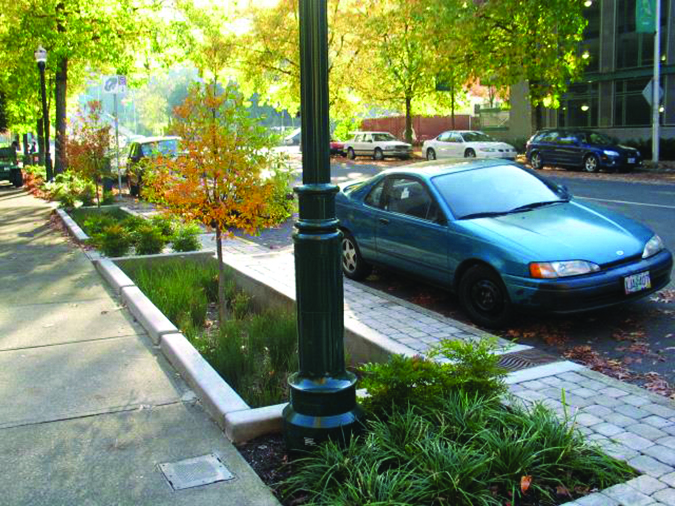VOLUME REDUCTION
Reducing the volume of stormwater runoff that enters the gray infrastructure system and local water bodies is a primary goal of green infrastructure projects. Volume reduction can be achieved through a combination of retention, evapotranspiration, and infiltration, depending on design goals.
Calculate the retention basin storage volume required to attenuate peak stormwater flows. Use rain gauges to collect rainfall data that sets a baseline on which to measure evapotranspiration rates and runoff.
Measure stormwater runoff in the drainage area before project construction, and then monitor either outfalls or bioretention cells after implementation to evaluate runoff volume reductions.
| Portland, OR |
 On SW 12th Street & Montgomery Street, four on-line planters have successfully retained 72–77% of runoff volume during storm flow tests. Designers also tested drawdown time, soil pollutants, and ponding depths for all four cells between 2007 and 2010. On SW 12th Street & Montgomery Street, four on-line planters have successfully retained 72–77% of runoff volume during storm flow tests. Designers also tested drawdown time, soil pollutants, and ponding depths for all four cells between 2007 and 2010. |
CHANNEL PROTECTION
GSI projects are often implemented to mitigate degradation of downstream rivers and creek beds. Urban stormwater runoff, especially frequent, high-volume flows, can cause riverbank erosion, which in turn can cause severe damage to bridge and sewer infrastructure or waterfront property. Channel degradation also negatively impacts wildlife habitat and biodiversity.
Direct measurements of the riverbanks and creek beds will give an indication of the project’s impact on downstream channel protection.
POLLUTANT LOADS
Rain that falls on the ground collects sediments, nutrients, and heavy metals as it flows across the street surface and into the stormwater management facility. Capturing and filtering these pollutants at the stormwater cell prevents downstream pollution or algae blooms that pose public health risks and degrade the environment.
Measure suspended solids in stormwater runoff as a proxy for measuring nutrient and heavy metal loading. Requirements for measuring water quality and pollutant loads are often determined by a consent order.
WATER QUALITY
Whether water is being detained and slowly released into the sewer system, or infiltrated into the ground, removing pollutants and improving water quality is a central goal of GSI projects for environmental restoration, public health, and regulatory compliance.
Measure the pollutant level in runoff entering the sewer system or local water bodies adjacent to the project site, both before and after project implementation, to assess improvements to water quality.
DRAWDOWN TIME
Bioretention facilities capture and store water before slowly releasing it into the sewer system or infiltrating it into the ground. Captured water must drain within the specified drawdown time, generally 24 to 72 hours, to limit the duration of ponding and ensure facilities can accommodate the next storm.
In some climates, drawdown time is especially important to prevent mosquito larva from developing in ponded water.
PLANT HEALTH
The ability of plants to survive and thrive is crucial to the green infrastructure’s stormwater management performance. Maintaining healthy plants is also key to community buy-in.
Plant health depends on soil mix, pollutant load, runoff flow intensity, salt spray, risk of trampling, and hardiness against flooding or drought. Species diversity is an important factor in providing more robust ecosystem services.
Evaluate whether plants are able to establish in the stormwater cell. Monitor plant health as a metric of project success. Monitor the presence of pollinators at green infrastructure projects.
FLOOD CONTROL
Green stormwater infrastructure projects are often implemented to reduce flooding, both on streets and in neighborhoods with high water tables and significant basement flooding.
Measure volume reduction at project outfalls to evaluate the impact on flood control. Track reports of traffic closures due to street flooding, as well as 311 calls or insurance claims of basement floods in buildings adjacent to the project area.
INFILTRATION RATES
Stormwater facilities, permeable pavements, and soil media are evaluated on their ability to infiltrate water. Infiltration rate, described in inches per hour, measures the rate at which water passes through the surface media, such as exposed soil or porous pavement.
Infiltration rates vary depending on project location, soil or pavement porosity, the soil’s ability to treat pollution and sediment, and the project’s distance from the water table. Other factors determining infiltration rates include seasonal changes to groundwater levels, shallow bedrock or other limiting soil layers, and historic industrial land use at the site with residual pollutant loads.
Infiltration rates should be designed to reduce pollutant loads passing through the soil media to the water table. Test the infiltration rate at the site before and after project installation to measure success. Continue to test for changes in infiltration rate over time.
SPECIES HABITAT
Native bee populations have declined in recent years due to habitat loss and pesticide use, posing a grave risk to the food crops that rely on pollination. In urban areas, human development threatens habitat for many pollinator species, including butterflies, moths, beetles, and hummingbirds.
Vegetated stormwater infrastructure with diverse, native plants can increase habitat for bees and other pollinators, restoring important ecological connections. Habitat restoration in urban areas is a foundational step to preserve healthy bee colonies, which support food crops for human consumption.
| Austin, TX |
| Austin City Council passed a 2015 resolution to incorporate native milkweed into city-owned properties to increase and improve pollinator habitat. Since then, the Austin Watershed Protection Department has included milkweed plants in green stormwater infrastructure projects to attract bees, monarch butterflies, and other pollinators. |